Gold prices edge higher on raised Fed rate cut hopes
Introduction & Market Context
Boeing Co (NYSE:BA) reported significant financial improvement in its first quarter 2025 earnings presentation released on April 23, with revenue increasing 17.5% year-over-year and operating margins turning positive. The aerospace giant is showing signs of recovery after a challenging period, with the stock trading up 4.26% in premarket at $169.45.
The results mark a substantial improvement from Boeing’s disappointing Q4 2024 performance, when the company reported an EPS of -$5.90 and revenue of $15.24 billion. The first quarter results reflect the company’s ongoing efforts to stabilize operations, improve execution, and rebuild trust with customers and investors.
Quarterly Performance Highlights
Boeing’s financial metrics showed broad improvement across most categories in Q1 2025 compared to the same period last year.
Revenue increased from $16.6 billion in Q1 2024 to $19.5 billion in Q1 2025, representing a 17.5% year-over-year growth. Operating margin improved significantly, turning positive at 2.4% compared to -0.5% in the prior year period. Core loss per share narrowed from -$1.13 to -$0.49, while free cash flow, though still negative, improved from -$3.9 billion to -$2.3 billion.
As shown in the following chart of key financial metrics:
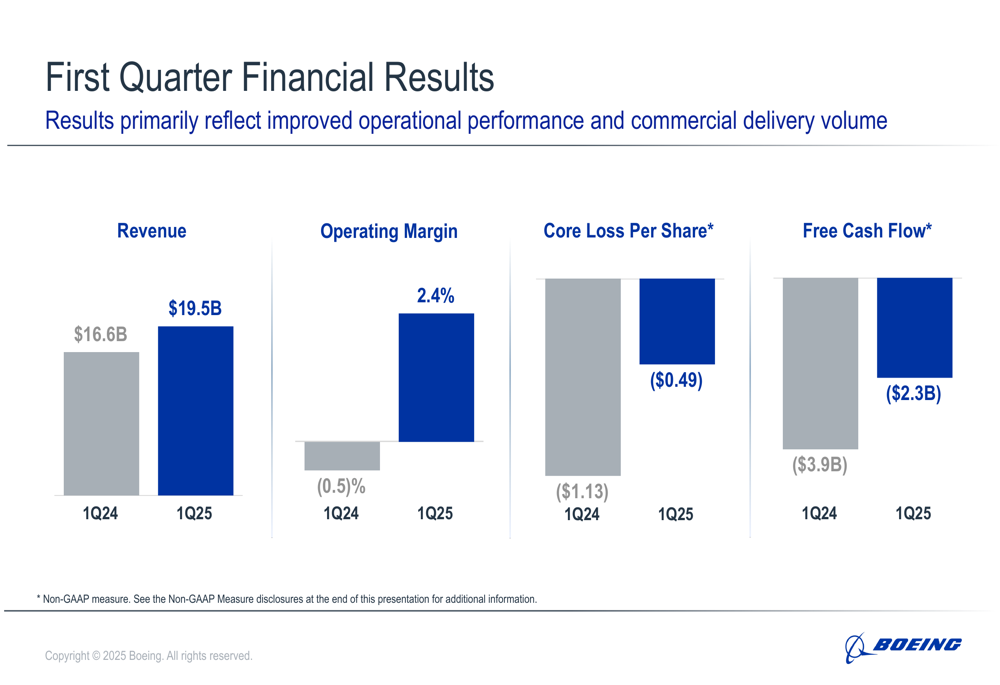
The company’s cash position decreased slightly from the previous quarter, with cash and marketable securities at $23.7 billion at the end of Q1 2025, down from $26.3 billion in Q4 2024. Consolidated debt also saw a slight reduction, decreasing from $53.9 billion to $53.6 billion. Boeing maintained its investment-grade credit ratings from all three major agencies (S&P:BBB-, Moody’s: Baa3, Fitch: BBB-).
Commercial Airplanes Performance
The Commercial Airplanes segment was the standout performer, with revenue surging 72.3% from $4.7 billion in Q1 2024 to $8.1 billion in Q1 2025. Operating margin, while still negative, improved dramatically from -24.6% to -6.6%, reflecting progress in the company’s recovery efforts.
The following chart illustrates the segment’s financial improvement:
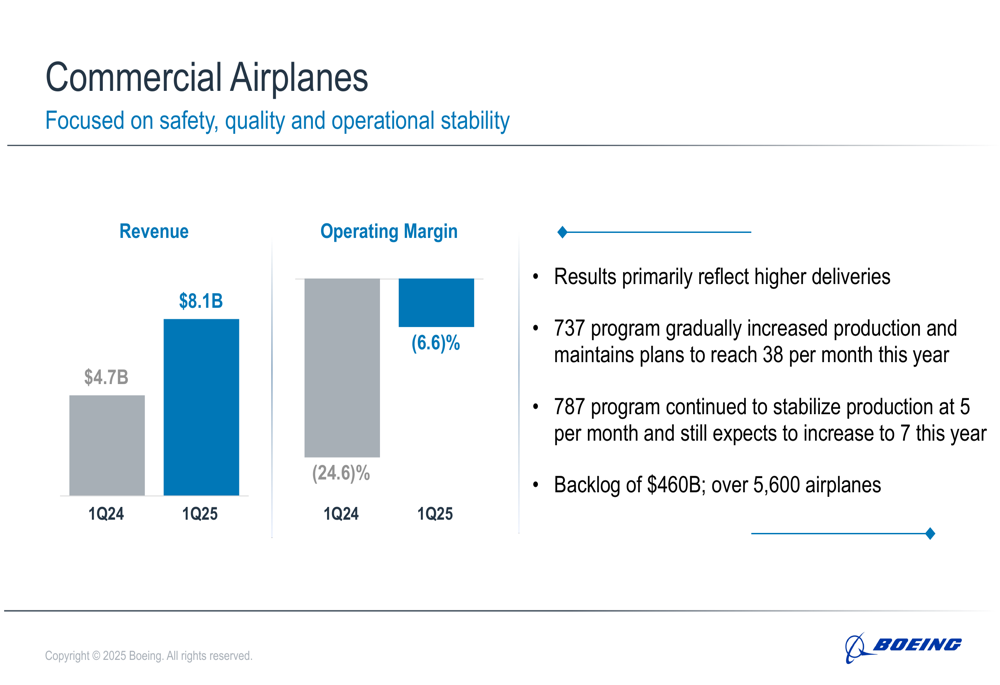
Boeing reported that the 737 program is gradually increasing production and maintains plans to reach 38 aircraft per month this year. The 787 program has stabilized production at 5 per month and still expects to increase to 7 per month later in 2025. The company’s commercial backlog remains robust at $460 billion, representing over 5,600 airplanes.
This performance represents a significant turnaround from Q4 2024, when production and delivery challenges severely impacted the commercial segment. The improvement suggests Boeing is making progress in addressing production issues that have plagued the company in recent years.
Defense and Services Segments
The Defense, Space & Security segment saw revenue decrease from $7.0 billion in Q1 2024 to $6.3 billion in Q1 2025, a 10% decline. However, operating margin improved slightly from 2.2% to 2.5%. A major highlight was Boeing’s selection by the U.S. Air Force to design, build, and deliver the F-47, its next-generation fighter aircraft.
The segment’s performance metrics are illustrated in the following chart:
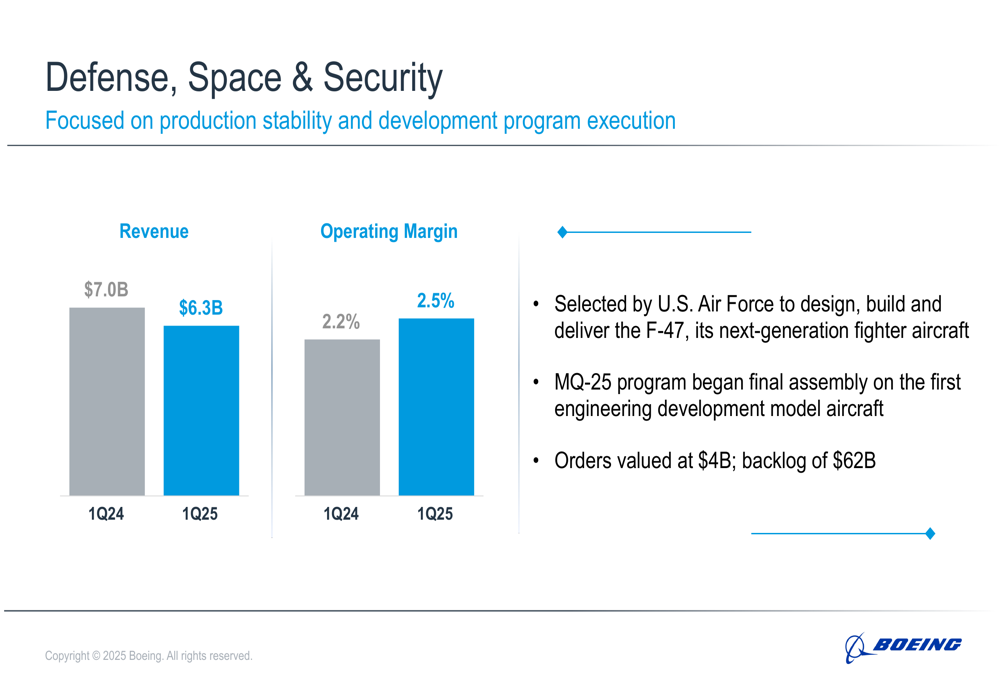
Meanwhile, the Global Services segment continued to deliver strong results, with revenue increasing slightly from $5.0 billion to $5.1 billion and operating margin improving from 18.2% to 18.6%. Key achievements included delivering the 100th 767-300 Boeing Converted Freighter to SF Airlines and receiving a modification contract from the U.S. Air Force to integrate electronic warfare systems for F-15.
The services segment’s consistent performance is shown in the following chart:

Both segments maintained solid backlogs, with Defense, Space & Security at $62 billion and Global Services at $22 billion, providing visibility for future revenue.
Cash Position and Outlook
Boeing’s cash and debt balances showed modest changes from the previous quarter. Cash and marketable securities decreased by $2.6 billion, while consolidated debt decreased by $0.3 billion.
The company’s cash and debt positions are illustrated in the following chart:
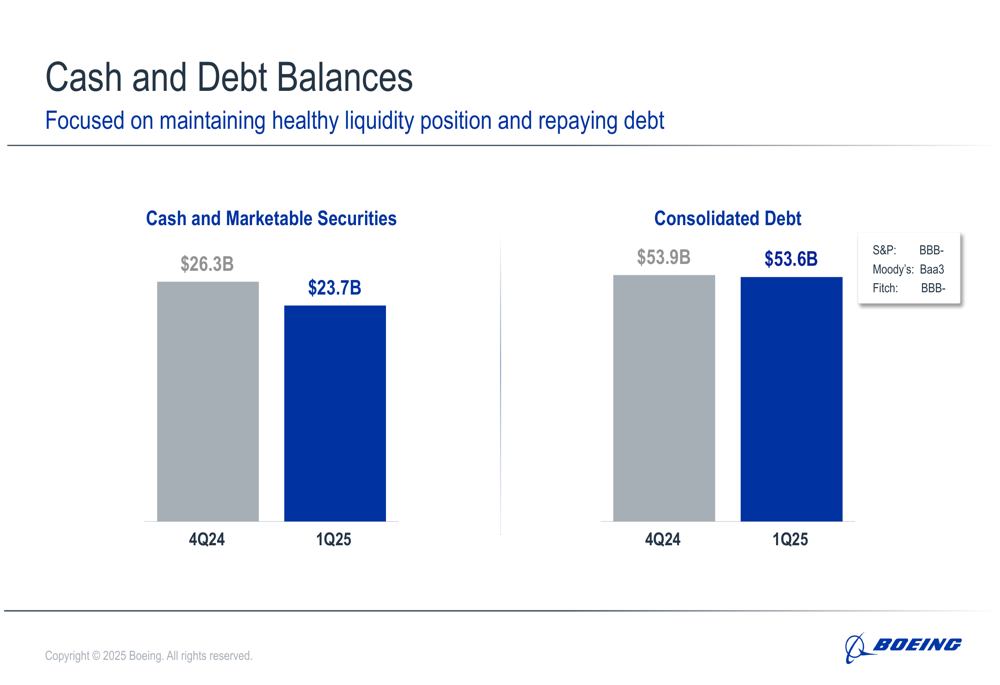
The improvement in free cash flow, though still negative at -$2.3 billion, represents progress compared to the -$3.9 billion reported in Q1 2024. This aligns with the company’s previous statements that 2025 would be a year of cash use, with significant free cash flow improvement expected in the latter half.
Strategic Initiatives
Boeing’s presentation emphasized four key areas of focus: stabilizing the business, improving execution, changing culture, and building for the future. The company provided visual representation of these strategic priorities:
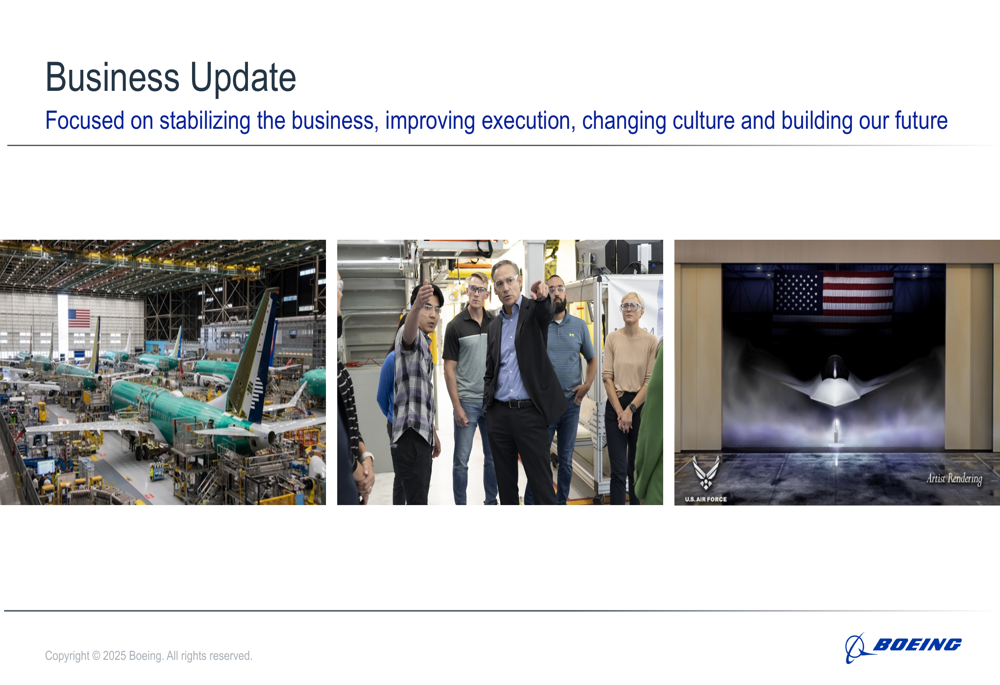
The company’s focus on stabilizing production, particularly for the 737 MAX and 787 programs, appears to be yielding results as evidenced by the improved financial performance. The gradual production rate increases for both programs suggest a measured approach to recovery, likely aimed at ensuring quality and safety.
Boeing’s selection for the F-47 fighter aircraft program and progress on the MQ-25 program highlight the company’s continued relevance in the defense sector despite recent challenges. These programs, along with the strong performance in the services segment, provide diversification as the commercial segment continues its recovery.
As Boeing moves through 2025, investors will be watching closely to see if the company can maintain this positive momentum, particularly in its commercial aircraft segment, while continuing to address production challenges and rebuild trust with customers, regulators, and the flying public.
Full presentation:
This article was generated with the support of AI and reviewed by an editor. For more information see our T&C.
